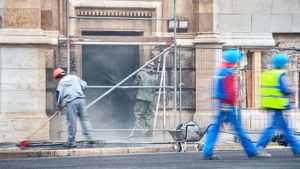Category: Uncategorized
Commercial Roofing Maintenance Schedule for The New Year
Having the roof on the commercial building you are in charge of maintained is essential for smooth business operations and ultimately for your success in business, too. If you already have a roofer to turn to for roofing emergencies, but you would like to implement a commercial roofing maintenance plan starting at the beginning of the following year, here is a breakdown of what you need to pay attention to:
- Your roofer’s experience – you need a roofer who specializes in the type of roof that you have. If the roofer you currently work with does not have ample experience of this kind, start looking for a contractor who can meet your expectations;
- Choose the services that you need – ask your roofer to perform a detailed inspection of your roof and to provide recommendations regarding the services that will work best for you. The most common maintenance services include regular roof surveys, inspections, roof and gutter cleaning, status reports and minor repairs;
- Choose the frequency of your maintenance sessions – roofing maintenance sessions should take place at 6-month intervals, but if your facility is located in a very windy or stormy region, you can schedule a detailed roof maintenance after each major storm to make sure that any problem caused by the storm is fixed in a timely manner, see http://www.nemasonry.com/new-england-roofing.
Can Snow Cause Problems with Your Roof?
Winter cannot be complete without snow, but a snow blanket that is too thick not only makes even the most common, daily chores more difficult to accomplish, but it can also be harmful to roofs. Here are some of the most common issues that snow can cause on your roof:
- Ice and snow, especially wet snow, are very heavy and they can press hard on your roof, causing not only the topmost layer of your roof to bend and to twist, but inducing structural changes in the deeper layers and support structures as well. The most common issues caused by excess weight on roofs are roof sagging, the appearance of leaks, cracks in the walls and cracking noises coming from everywhere in the house – if you notice any of these, call expert help at once because you are faced with a potentially dangerous situation;
- The formation of ice dams – icicles form when the warm air from inside the home rises to the roof and melts the snow on it, transforming it into water that runs down on the slope of the roof and freezes again. Ice dams are dangerous because they can harm the roof and they can tear or break the gutters to which they attach. The same is true with roof issues during the winter for your commercial building, a commercial roofing CT contractor should be called immediately.
How to Get Your Commercial Roof Ready for Winter
Commercial roofs are in many ways like residential roofs: they need attention and care to be able to serve you well. With rain, snow, ice and freezing weather on their way, your commercial roof needs to be properly prepped, so here are a few of the things that you need to do to make sure your roof can go through winter without leaks and other damage:
- Get your roof cleaned and inspected by elite commercial roofing Connecticut professionals – whatever your roof type, it needs to be cleaned before settles in to make sure that there is no debris that can trap water and damage the roof. When the surface is clean, your roofing team can start inspecting the roof inch by inch to identify any problems or weak points. The process should be extended to the gutters as well – without properly working, obstruction-free gutters, no roof can stay healthy for long;
- Take care of any repairs and fortify the roof – make sure that all the roofing and gutter-related issues are fixed and the roof is fortified to be able to withstand the weight of snow. Fresh, dry snow weighs 20 pound per cubic foot and wet snow is even heavier, so you need a strong roof to stand up to that weight (and you will also need to remove as much of the fresh snow as possible right after the snowing stops).
Things to Expect from The Process of Building Restoration
Building restoration is the process of bringing an old building back to its original state of beauty and functionality and usually the path to take in the case of buildings that have components of historic value, such as old flooring, stairs, windows and doors the original beauty and functionality of which could be restored.
While building remodeling and renovation usually involves the replacement of floors, doors and windows, the principle goal of restoration is preservation, therefore the methods used during the restoration process are different from the strategies used for remodels – here is what to expect:
- Flooring – the first step in floor restoration is inspection, followed by cleaning to reveal damaged blocks. The damaged components are removed and recreated by an expert, then the new elements are installed and the entire flooring is sanded to restore its smoothness. In the final phase, a suitable finishing method is chosen and applied;
- Doors and windows – the process of restoring old doors and windows is very similar to the process of restoring the floor;
- Restoring old fixtures – old lamps and chandeliers are also retouched during building restoration. Very often, the process also involves the revealing and the inspection of the entire electrical system in the building, usually followed by improvements of the system;
- Plumbing – the plumbing also needs lots of attention in most old buildings – in most cases, the ducts and lines in very old buildings do not comply with modern building regulations and they are replaced with modern systems. There are building restoration experts such as http://www.nemasonry.com that are great at what they do.
The Nuances of Building Restoration
Building restoration is not all about tearing down walls, lifting heavy objects and working with high-capacity tools. It is also about work that requires finesse, taste and patience, work with the nuances that make all the difference – here are some of the building restoration processes:
- Interior masonry – working with natural stone is both a craft and an art. The stones to be used need to be picked carefully and they need to be handled with care as well because only such care can ensure that your masonry wall, your flooring or your fireplace turns out the way you want it to;
- Painting – the process of building restoration inevitably involves painting work as well. If the wall has been painted several times over the years, great care must be taken to remove all the residues of the old paint, then the wall needs to be washed and prepared to receive the new paint and the application of the new coat also needs lots of attention;
- Wood restoration – restoring wood elements, such as solid wood flooring or solid wood doors the surface of which looks worn, but are otherwise in great condition is also a process that requires respect for the material, vast knowledge and experience in restoring old wood and dexterity.




















